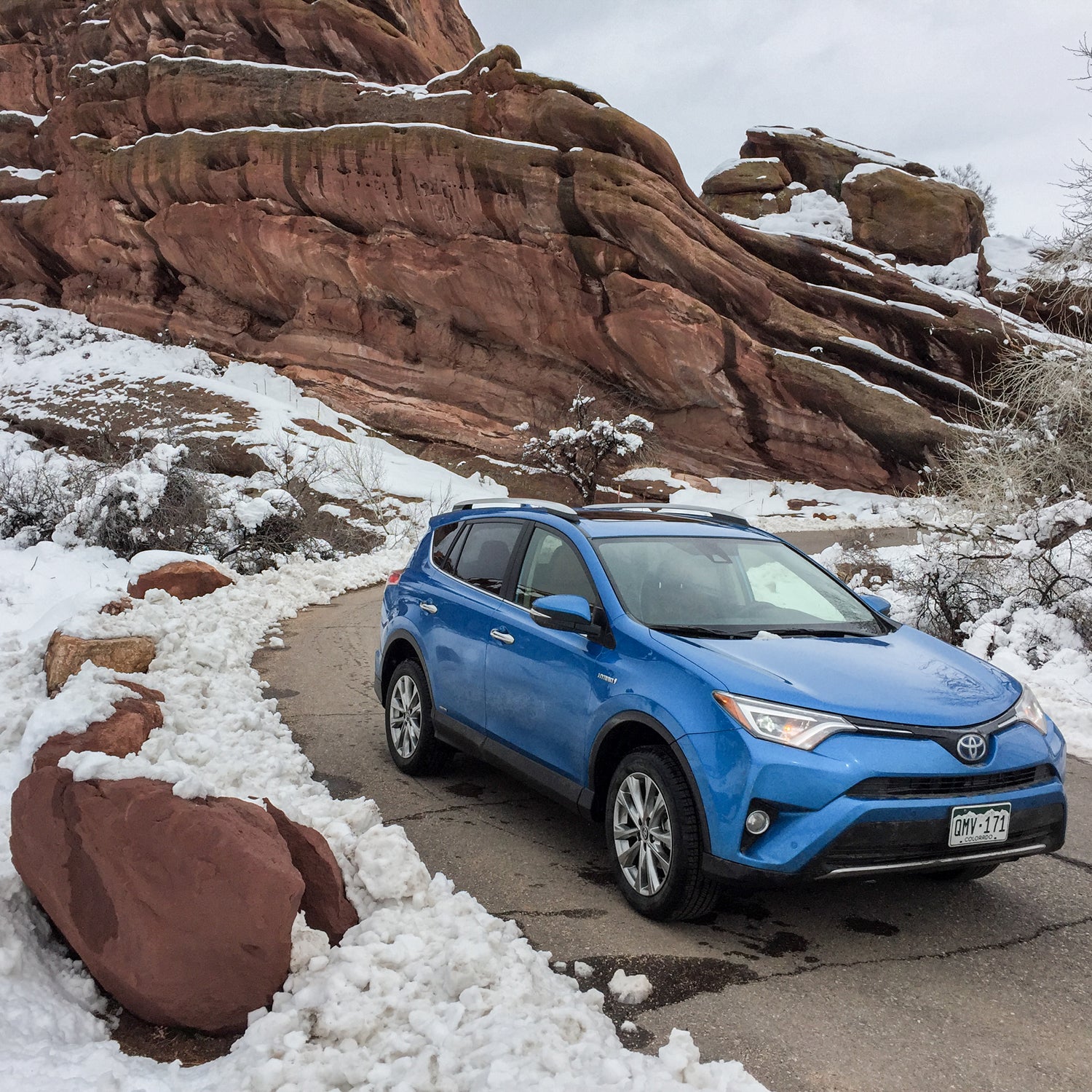The RAV4 Hybrid definitely wins sleeper SUV of the year. We want one.
The Takeaway
The Good:┬áI was shocked by how┬ácapable the┬áRAV4┬áwas in a blizzard that dumped 14 inches of heavy, wet spring snow on Denver. The compact SUVÔÇÖs 6.3┬áinches of ground clearance and sophisticated AWD system kept the Toyota moving on roads that stymied other vehicles. To boost traction, I left the vehicle in Eco mode, which cut the amount of torque to the wheels,┬árolling┬áthe car out and through the deep powder instead of spinning its wheels. The absence of a front spoiler, common among SUVs and trucks, allowed the Toyota to punch over drifts instead of getting stuck.
ÔÇőThe Bad:┬áDue to the inclement weather and a high-speed run into the mountains, the hybrid didnÔÇÖt match its combined EPA fuel economy numbers, even though I left it in Eco mode the entire time. (Really, why else would you buy a hybrid?)┬áStill it came┬áclose. Also, the steering wheel doesnÔÇÖt telescope out quite enough. A bummer, since the rest of the driverÔÇÖs seat ergonomics are completely dialed.
The Verdict:┬áThis is the┬áhybrid compact SUV for those who truly need AWD capabilitiesÔÇöand itÔÇÖs affordable. Eco mode both maximizes fuel economy and turns the car into a snow machine. With ToyotaÔÇÖs decade-plus experience building hybrids, combined with its vehiclesÔÇÖ┬álegendary durability, the┬áRAV4┬áHybrid is a worthy alternative to the legendary Outback.
Specs
Price: $28,370 (base); $33,610 (as tested)
ÔÇőE▓ď▓Áż▒▓ď▒:╠ř2.5-liter inline, 150-horsepower, 4-cylinder engine┬ápowering the front wheels, and a 67-horsepower┬áelectric/hybrid motor for the rear wheels
Â┘░¨ż▒▒╣▒│┘░¨▓╣ż▒▓ď:╠řCVT automatic, AWD
ÔÇőEPA Fuel Economy:┬á33 mpg combined; 34 mpg city/31 mpg hwy; 31.4 mpg observed
The Engine
The RAV4ÔÇÖs 2.5-liter engine puts out 150 horsepower┬áand powers only the front wheels. A separate electric motor powers the rear wheels and is called in to help with acceleration┬áor when the front wheels slip. The electric motor runs by itself when the vehicle turns over to electric┬ávehicle mode, which happens on residential streets at up to roughly 20┬ámiles per hour┬áor when the car goes downhill. ItÔÇÖs a cool concept┬ábut doesnÔÇÖt appear to do much to boost fuel economy. That said, like most hybrids, the Toyota did great in stop-and-go city trafficÔÇöa trip downtown produced my best numbers of the week, at 34 miles per gallon.
Performance-wise, the two engines spirited me up to 8,000 feet on the interstate at 70 miles per hour┬áwithout a hitch,┬áalthough the gas engine and transmission had to work hard to maintain speed, as evidenced by the 20 miles per gallon┬áI averaged. ItÔÇÖs no sports car, but it gets the job done.
The Ride
The RAV4 HybridÔÇÖs wheel has a soft feel. ThereÔÇÖs no visceral connection to the road through the tires;┬áhowever, it rolls smoothly for a small SUV, which I attributed to the hybrid┬ábeing 320 pounds heavier than the nonhybrid. The downside is that on twisting roads and in high-speed corners, that weight produces more side-to-side body roll.
Cargo
The interior layout is highly functional.┬áThe battery and rear-wheel┬ádrivetrain┬átake up just two cubic feet of interior room compared to the nonhybridÔÇömuch less than I imagined. With the rear seat up,┬áthereÔÇÖs room in back for a golden retriever. Fold the rear seats down, and you can store a mountain bike sans front wheel. Rear-seat passengersÔÇöeven six-footersÔÇöhave enough room to sit comfortably for long stretches┬áwhile giving front-row passengers plenty of room.
Buying Advice
If you want the AWD functionality and cargo capacity of an Outback but with better city fuel economy┬áand the driverÔÇÖs vantage point of a SUV, the Toyota RAV4 is worth a look. ItÔÇÖs also┬árelatively affordable. Sure, youÔÇÖll spend a few thousand more dollars for the hybrid, but we think the green upgradeÔÇÖs worth it for the bump in urban fuel┬áperformance.



